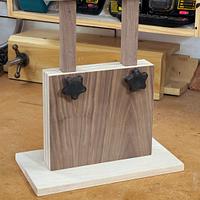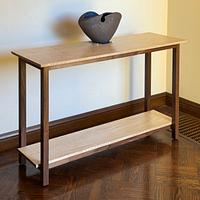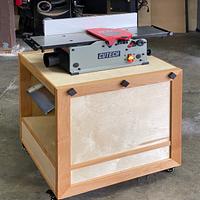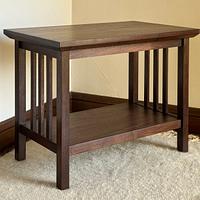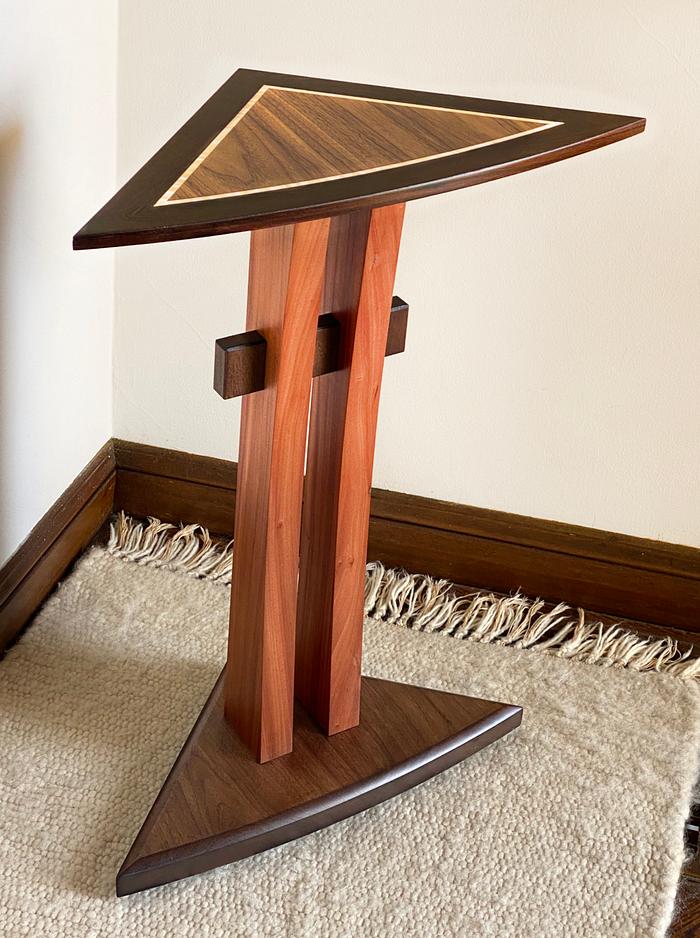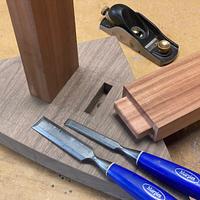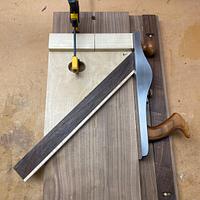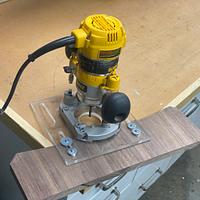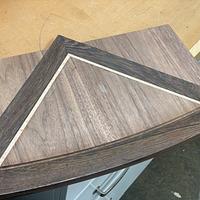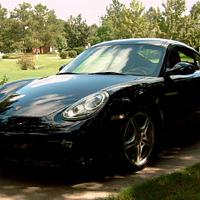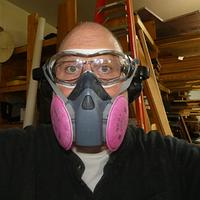Share your craft projects
Make new craft buddies
Ask craft questions
Blog your craft journey

Fotodog
132 posts
and
7 followers
in over 1 year
in over 1 year
More from Fotodog
Contemporary Corner Table
I built this corner table for my wife’s daughter and her husband. They like a more contemporary look, as do I. I didn’t see anything that I really liked with Google searches, so I came up with a few designs in Sketchup. They picked one, and also asked if I could incorporate some inlay like I’ve done with jewelry boxes. I hadn’t done inlay with curves before, so I used this project as a learning opportunity.
The bottom is 1 3/4” thick Walnut to add weight and stability. I gave the edges a strong roundover profile to lighten the look. The legs are Sapele, attached to the base with mortise and tenon joinery. After seeing a dry fit, I decided to give the legs a slight curve in the front. The leg braces are Walnut.
The top was an interesting assembly. The more I thought about the curved front inlay, the more complicated it became. As you know, the same curve cannot be used for different radius curves. Here’s my approach: I milled the triangular Walnut center extra long in the front. I then glued up the 1 1/2” wide Wenge side trim pieces with 1/4” Curvy Maple inlay, mitered at 45 degrees in the back, and glued those onto the center Walnut piece, again extra long in the front. I temporarily super glued the Walnut off cuts to the 45 degree sides to provide a right angle for glue up, and left those on for the final planing to avoid tearout on the Wenge edges. Now came the challenge of cutting the proper curves for that assembly, the front curved Wenge trim, and routing the curved front inlay. For these tasks, I used templates.
I built a quick circle cutting jig for my router, making it 5 feet long to produce a template with the gentle curve I wanted for the outside edge of the table. I then shortened the pivot point of the jig by 1 1/2 inches and used a 1/4” bit to provide the proper curve for the already assembled center section. After cutting the curve on the Walnut center section, I cut the proper curve in the Wenge trim and glued it in place. Using one of the templates as an edge guide for my router, I routed the 1/4” groove for the front curved inlay, cleaned up the edges with a chisel, and installed the inlay.
I wanted more contrast between the base and braces with the Sapele legs, so I used Transtint Walnut dye to slightly darken the Walnut on those pieces. The entire piece was then finished with Osmo PolyX satin. The top was attached with figure 8 fasteners to allow for wood movement.
The kids were happy, so all went well. Thanks for looking.
The bottom is 1 3/4” thick Walnut to add weight and stability. I gave the edges a strong roundover profile to lighten the look. The legs are Sapele, attached to the base with mortise and tenon joinery. After seeing a dry fit, I decided to give the legs a slight curve in the front. The leg braces are Walnut.
The top was an interesting assembly. The more I thought about the curved front inlay, the more complicated it became. As you know, the same curve cannot be used for different radius curves. Here’s my approach: I milled the triangular Walnut center extra long in the front. I then glued up the 1 1/2” wide Wenge side trim pieces with 1/4” Curvy Maple inlay, mitered at 45 degrees in the back, and glued those onto the center Walnut piece, again extra long in the front. I temporarily super glued the Walnut off cuts to the 45 degree sides to provide a right angle for glue up, and left those on for the final planing to avoid tearout on the Wenge edges. Now came the challenge of cutting the proper curves for that assembly, the front curved Wenge trim, and routing the curved front inlay. For these tasks, I used templates.
I built a quick circle cutting jig for my router, making it 5 feet long to produce a template with the gentle curve I wanted for the outside edge of the table. I then shortened the pivot point of the jig by 1 1/2 inches and used a 1/4” bit to provide the proper curve for the already assembled center section. After cutting the curve on the Walnut center section, I cut the proper curve in the Wenge trim and glued it in place. Using one of the templates as an edge guide for my router, I routed the 1/4” groove for the front curved inlay, cleaned up the edges with a chisel, and installed the inlay.
I wanted more contrast between the base and braces with the Sapele legs, so I used Transtint Walnut dye to slightly darken the Walnut on those pieces. The entire piece was then finished with Osmo PolyX satin. The top was attached with figure 8 fasteners to allow for wood movement.
The kids were happy, so all went well. Thanks for looking.
11 Comments
Beautiful table! The top and the legs have a nice shape.
cool design. i like the wood combo works well. nice work.
working with my hands is a joy,it gives me a sense of fulfillment,somthing so many seek and so few find.-SAM MALOOF.
Neat table and the inlay work is great. Well done
Ron
Wonderful gift!
Wow, Dog...that rock's! Well done
Mike
New age modern, or rock of ages gospel. looks enough like a pulpit to go there. Interesting one of a kind piece. Mike nailed it. it rocks.
Very nice! Well done.
Ryan/// ~sigh~ I blew up another bowl. Moke told me "I made the inside bigger than the outside".
Good looking table
Thanks everyone, it was a fun build. I always enjoy problem solving and learning new skills.
Great design. Beautiful work on it!!
Cheers, Jim ........................ Variety is the spice of life...............Learn something new every day
That's one great looking corner table!
Fine option versus just going square and really lets you get artistic with the curves and colors.
👍
Fine option versus just going square and really lets you get artistic with the curves and colors.
👍









